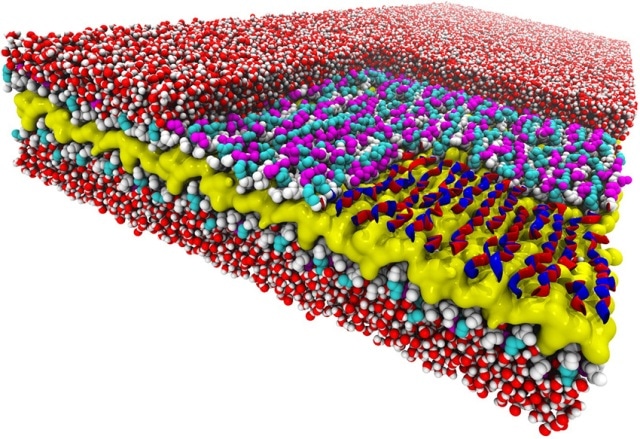Jun 8 2016
Researchers should have knowledge about how to refine and use synthetic materials that can tolerate industrial conditions to imitate the natural ability of proteins as catalysts, sensors, etc. A collaboration between researchers and Molecular Foundry staff, led to the discovery of a new design rule that regulates the way by which polymer building blocks combine to form the backbones that run along the length of small biomimetic sheets.
 Snakes on a plane: This atomic-resolution simulation of a peptoid nanosheet reveals a snake-like structure never seen before. The nanosheet’s layers include a water-repelling core (yellow), peptoid backbones (white), and charged sidechains (magenta and cyan). The right corner of the nanosheet’s top layer has been “removed” to show how the backbone’s alternating rotational states give the backbones a snake-like appearance (red and blue ribbons). Surrounding water molecules are red and white. (Image courtesy- Molecular Foundry, Berkeley Lab)
Snakes on a plane: This atomic-resolution simulation of a peptoid nanosheet reveals a snake-like structure never seen before. The nanosheet’s layers include a water-repelling core (yellow), peptoid backbones (white), and charged sidechains (magenta and cyan). The right corner of the nanosheet’s top layer has been “removed” to show how the backbone’s alternating rotational states give the backbones a snake-like appearance (red and blue ribbons). Surrounding water molecules are red and white. (Image courtesy- Molecular Foundry, Berkeley Lab)
The Impact
Knowledge about the rules that control the self-assembly of nanosheets can be utilized to assemble complex sheet structures, like crystalline solids and nanotubes that can be modified into long-lasting catalysts or highly sensitive chemical detectors.
Summary
Researchers hope to construct nanostructures that imitate the function and complexity of natural proteins, but are constructed with synthetic and durable materials. These tiny widgets can be modified into chemical detectors or catalysts.
However, scientists must gain knowledge on how to refine the materials they would use to construct these structures. A recent finding by researchers at the Molecular Foundry is the ‘design rule’ that allows a newly formed peptoid nanosheet material to survive. This material has a flat structure, which is just two molecules thick and contains peptoids, which are artificial polymers similar to protein-forming peptides.
The design rule regulates the means in which polymers combine to create the backbones that run along the length of nanosheets. Astonishingly, these molecules link in a counter-rotating pattern that was never observed in nature. This pattern permits the backbones to remain untwisted and linear, thereby making peptoid nanosheets flatter and larger than any biological structure.
The researchers at Molecular Foundry explained that this new design rule could be utilized to assemble complicated nanosheet structures and various other peptoid assemblies like crystalline solids and nanotubes. The team found this by integrating computer simulations at National Energy Research Scientific Computing Center, another DOE user facility at Berkeley Lab, with imaging and x-ray scattering techniques to examine the atomic-resolution structure of peptoid nanosheets for the first time.
Funding
Part of this study was carried out as a user project at the Molecular Foundry at Lawrence Berkeley National Laboratory, supported by the Office of Science, Office of Basic Energy Sciences, of the US Department of Energy under contract no. DE-AC02-05CH11231. R.V.M., T.K.H., C.P., E.J.R., A.B., R.N.Z., and S.W. were supported by the Defense Threat Reduction Agency under contract no. IACRO-B0845281. C.P. was also supported by the Natural Sciences and Engineering Research Council of Canada (NSERC PDF). R.N.Z. and S.W. were also supported by the Office of Science, Office of Basic Energy Sciences, of the US Department of Energy under contract no. DE-AC02-05CH11231. We thank G. K. Olivier for providing the atomic force microscopy data. This work used resources of the National Energy Research Scientific Computing Center, which is supported by the Office of Science of the US Department of Energy under contract no. DE-AC02-05CH11231. Quantum-mechanical calculations were carried out on the High Performance Computing resources at New York University Abu Dhabi.